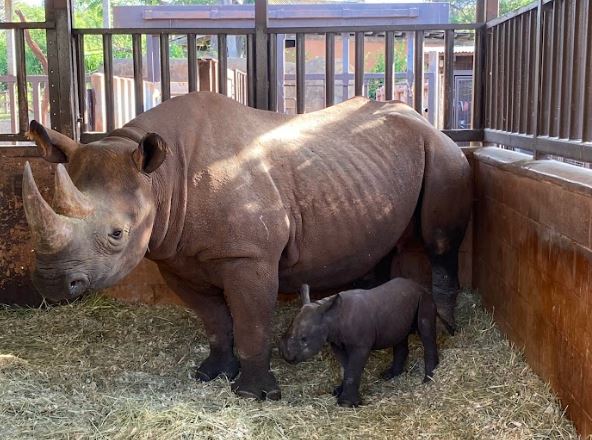Community website by MBC/Ernest Abrams. Call 808-739-9797 for advertising/sponsorship.
Kakaako - Honolulu, Hawaii
News Item- Powered by MBC NewsMaker
The Honolulu Zoo Announces Birth Of Its First Baby Rhinoceros
- Tweet

Aria and baby black rhinoceros at the Honolulu Zoo
WAIKĪKĪ – The Honolulu Zoo is happy to announce the arrival of a new baby Eastern black rhinoceros born on Wednesday, April 19, 2023, to parents Aria (mother) and Kendi (father). The male baby is the first offspring of the rhino couple who arrived at the Honolulu Zoo from San Diego last September and November. These parents were identified as a breeding pair as a part of the Association of Zoos and Aquariums (AZA) Species Survival Plan (SSP).
“We are all so thrilled with the very first birth of a rhinoceros at the Honolulu Zoo,” said Honolulu Zoo Director Linda Santos. “We celebrate a successful SSP pairing and are very fortunate to have such a special educational opportunity for our staff to observe Aria throughout her pregnancy and watch her delivery. Everyone is very excited to work with the black rhinos and monitor the baby’s progress and development. Our animal care staff have done an excellent job preparing for the baby’s arrival and it was truly remarkable to see the baby stand, walk, and start to bond with his mom within the first hour of being born.”
The calf weighs approximately 50 pounds, 1/50th of Aria’s weight of 2,600 pounds, and is nursing regularly. He is curious, displays a playful personality, and stays close to his mother. The baby’s name will be determined at a later date. Aria and her calf will share one half of the rhino exhibit and Kendi will occupy the other half until they can be safely integrated together.
Kendi can currently be seen on exhibit in the African Savanna near the play apparatus at the Honolulu Zoo. Aria and her baby are expected to venture out on exhibit within the next couple of months. Visitors are welcome to take a peek at the rhino family and are encouraged to be respectful while viewing and taking photos.
The critically endangered Eastern black rhino is the smaller of the two African rhino species, the other being the white rhino. They stand up to five feet high at the shoulder and are approximately 12 feet in length. They weigh up to 3,000 pounds, have three toes, thick dark brown to gray colored skin, and two fibrous keratin horns. They are best distinguished from the white rhino by their pointed, rather than square upper lip and are reported to live up to 35 years in the wild and up to 50 years in human care.
Questions? Ready for an appointment?
Featured Product/Service
- RELATED LINKS
Calendar
Check out things to do in Kakaako, Hawaii on the calendar of events.News and Newsletters
Keep up with the latest news and happenings in the Kakaako, Hawaii community.Featured Sponsors Offers
Great offers from our sponsors who support the Kakaako, Hawaii Community More...Kakaako, Hawaii Coupons & Discounts
Save money in Kakaako, Hawaii with these coupons.Kakaako, Hawaii Featured Pages
View our directory of feature pages showcasing all the great things Kakaako has to offer.About Kakaako - Honolulu Hawaii
Learn about Kakaako, Hawaii.About Kakaako Hawaii .com
Learn about Kakaako Hawaii .com website and its creator.
Please send questions about this website to
Copyright© 2014 - 2023 KakaakoHawaii.com. All rights reserved.
Terms of Use / Legal Disclaimer / Privacy Statement
Site Designed and Managed by MacBusiness Consulting
Terms of Use / Legal Disclaimer / Privacy Statement
Site Designed and Managed by MacBusiness Consulting
